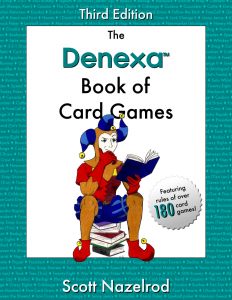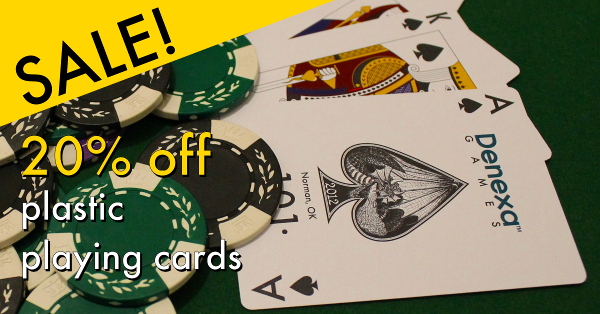Lórum
Lórum is a card game for four players. Lórum is a great example of a compendium game, rolling seven different styles of game play into one game. In Lórum’s case, the first four hands are played as a trick-taking game. Then, it’s followed up with a point-counting game. The two final hands are Stops games. Then, the cycle begins anew, with a new dealer.
Lórum originated in Hungary at the very beginning of the 20th century. It is the oldest member of a group of compendium games that all involve avoiding tricks. Other games likely descended from Lórum are the French game Barbu and the Russian game King.
Object of Lórum
The object of Lórum is to have the most chips after 28 hands. On some hands, players collect chips by avoiding taking certain cards, which vary from hand to hand. On others, the goal is to run out of cards first.
Setup
To play Lórum, you’ll need a 32-card deck of cards. You can easily make such a deck out of a sturdy deck of Denexa 100% Plastic Playing Cards by removing all the 6s through 2s. You’ll be left with a deck that has only aces, face cards, and 10s through 7s in each of the four suits.
Lórum is typically played with hard scoring, so you’ll need a bunch of tokens or chips. An amount of real money may be attached to each chip, if desired. If so, each player purchases however many chips they’d like to start the game with. Otherwise, distribute the same number of chips to each player.
Determine the first dealer randomly. This dealer will deal the first seven hands, then pass to the next dealer, who will deal the next seven, and so on. Shuffle and deal eight cards to each player, exhausting the whole pack.
Game play
A game of Lórum cycles through seven different types of hands. Several of these are trick-taking games. The player to the dealer’s left leads to the first trick. Each player, proceeding clockwise, plays one card to the trick. They must follow suit if able; otherwise, they can play any card they wish. Whoever played the highest card of the suit led wins the trick; they take the cards and place them in a face-down won-tricks pile in front of them. That player then leads to the next trick.
Cards rank in their usual order, with aces high.
The seven hands
1. No hearts
The first hand is played as a trick-taking game. Hearts cannot be led to the first trick.
After all eight tricks have been played, each player counts up the number of hearts in their won-tricks pile. What happens next depends on how many players captured hearts:
- All players took at least one heart: For each heart captured, a player pays one chip to the pot.
- Three players took hearts, and one didn’t: For each heart captured, a player pays one chip directly to the person who didn’t take any hearts. The player who didn’t take any hearts will collect eight chips from their opponents.
- Two players took hearts, two didn’t: For each heart captured, a player pays one chip. The two players who didn’t take hearts each get four of these chips.
- One player took all eight hearts: Each player who didn’t take hearts has to pay the one who took the hearts eight chips! They’ll end up receiving a total of 24 chips from their opponents.
2. Queens
In this trick-taking hand, players must pay when they capture queens. Capturing the Q♥ costs four points, the Q♦ three, the Q♠ two, and the Q♣ one.
- All players took one queen: Players pay into the pot.
- Three players took queens, and one didn’t: The players who took queens pay the person who didn’t directly. The player who didn’t take any queens will collect ten chips from their opponents.
- Two players took hearts, two didn’t: The two players who captured queens pay, and the ten chips are split between the two players who didn’t take queens.
- One player took all four queens: Each player who didn’t take queens has to pay the one who took the queens ten chips! The player who captured all four queens gets a total of 30 chips from their opponents.
3. No tricks
A trick-taking hand where the aim is to avoid taking any tricks at all. Be sure to keep the tricks separate in the won-tricks pile by placing them atop each other at right angles to one another. Payments are made the same as on the no-hearts hand.
4. Hairy Ape
Players do not look at their cards as they’re being dealt. Instead, they pick their cards up and hold them with their backs facing them. This means that they can only see their opponents’ hands and not their own. Players then play a faintly ridiculous trick-taking game. If at least one of the cards played follows suit to the lead, the trick is captured by the highest card of the suit led, as normal. Otherwise, each player captures their own card. Whoever captures the K♥ pays four chips into the pot.
For a more serious game, hold the cards facing toward you and just play a normal trick-taking game, avoiding capturing the K♥.
In any case, once the K♥ has been captured, there’s no point in playing the hand out. The deal can be abandoned at that point.
5. Train
For this hand, aces count eleven each, kings count four, queens are worth three, jacks two, and 10s one. The remaining ranks (9s, 8s, and 7s) have no value. The player to the dealer’s left plays any card they wish, and call out its value. The next player to the left plays a card, calling out the combined total of their card and the one before it, and so on.
The player who makes the running total greater than or equal to 25 must pay a chip into the pot. The player who brings the count to 50 pays two chips, to 75 three chips, and to 100 four chips.
6. Quart
The player to the dealer’s left plays any card they wish. The player who holds the next higher card of the same suit plays it, regardless of turn order. When an ace is played, it is followed by the 7 of that suit. This continues until either four cards have been played, or play cannot continue because the card continuing the sequence has already been played. When this happens, the cards are turned face down, and the last person to play may play whatever they like, starting a new sequence.
The hand continues until someone runs out of cards. Each of their opponents pays that player one chip for every card they hold.
7. Domino
The player to the dealer’s left begins by playing any card they want. The next player must then play a card of the same suit either one rank below or one rank above the starter, placing it to the left or the right of the starter respectively. They may also play another card of the same rank as the starter, placing it below the starter to begin a new row. Game play continues in this manner, with the players laying the deck onto the table in a grid-like layout. If a player has no valid card to play on their turn, they pass.
When a player runs out of cards, each of their opponents pays one chip into the pot for every card they hold. The winning player then takes the entire pot.
The eighth hand onward
After playing seven hands with the same dealer, the deal passes to the left. The new dealer will then deal the next seven hands, starting with a no-hearts hand, and running through the above cycle. Then they pass the deck off to the next dealer, and so on. The game continues until all four players have dealt seven hands. Whichever player has the most chips at that point wins the game.



